Rosa Bonheur
 From Wikipedia - Reading time: 17 min
From Wikipedia - Reading time: 17 min
Rosa Bonheur | |
|---|---|
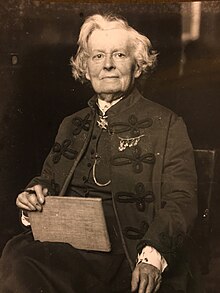 Rosa Bonheur, c. 1895–99 | |
| Born | Marie-Rosalie Bonheur 16 March 1822 Bordeaux, France |
| Died | 25 May 1899 (aged 77) Thomery, France |
| Known for | Painting, sculpture |
| Notable work | Ploughing in the Nivernais, The Horse Fair |
| Movement | Realism |
| Father | Oscar-Raymond Bonheur |
| Signature | |
Rosa Bonheur (born Marie-Rosalie Bonheur; 16 March 1822 – 25 May 1899) was a French artist known best as a painter of animals (animalière). She also made sculptures in a realist style.[1] Her paintings include Ploughing in the Nivernais,[2] first exhibited at the Paris Salon of 1848, and now in the Musée d'Orsay in Paris, and The Horse Fair (in French: Le marché aux chevaux),[3] which was exhibited at the Salon of 1853 (finished in 1855) and is now in the Metropolitan Museum of Art in New York City. Bonheur was widely considered to be the most famous female painter of the nineteenth century.[clarification needed][4]
It has been claimed that Bonheur was openly lesbian, as she lived with her partner Nathalie Micas for over 40 years until Micas's death, after which she lived with American painter Anna Elizabeth Klumpke.[5] However, others remark that nothing supports this claim.[6]
Early development and artistic training
[edit]Bonheur was born on 16 March 1822 in Bordeaux, Gironde, the oldest child in a family of artists.[7] Her mother was Sophie Bonheur (née Marquis), a piano teacher; she died when Rosa was eleven. Her father was Oscar-Raymond Bonheur, a landscape and portrait painter who encouraged his daughter's artistic talents.[8] Though of Jewish origin,[9] the Bonheur family adhered to Saint-Simonianism, a Christian socialist sect that promoted the education of women alongside men. Bonheur's siblings included the animal painters Auguste Bonheur and Juliette Bonheur, as well as the animal sculptor Isidore Jules Bonheur. Francis Galton used the Bonheurs as an example of the eponymous "Hereditary Genius" in his 1869 essay.[10]
Bonheur moved to Paris in 1828 at the age of six with her mother and siblings, after her father had gone ahead of them to establish a residence and income there. By family accounts, she had been an unruly child and had a difficult time learning to read, though she would sketch for hours at a time with pencil and paper before she learned to talk.[11] Her mother taught her to read and write by asking her to choose and draw a different animal for each letter of the alphabet.[12] The artist credited her love of drawing animals to these reading lessons with her mother.[13]
At school she was often disruptive, and was expelled numerous times.[14] After a failed apprenticeship with a seamstress at the age of twelve, her father undertook her training as a painter. Her father allowed her to pursue her interest in painting animals by bringing live animals to the family's studio for studying.[15]
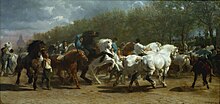
Following the traditional art school curriculum of the period, Bonheur began her training by copying images from drawing books and by sketching plaster models. As her training progressed, she made studies of domesticated animals, including horses, sheep, cows, goats, rabbits and other animals in the pastures around the perimeter of Paris, the open fields of Villiers near Levallois-Perret, and the still-wild Bois de Boulogne.[16] At fourteen, she began to copy paintings at the Louvre.[8] Among her favorite painters were Nicolas Poussin and Peter Paul Rubens, though she also copied the paintings of Paulus Potter, Frans Pourbus the Younger, Louis Léopold Robert, Salvatore Rosa and Karel Dujardin.[16]
She studied animal anatomy and osteology in the abattoirs of Paris and dissected animals at the École nationale vétérinaire d'Alfort, the National Veterinary Institute in Paris.[17] There she prepared detailed studies that she later used as references for her paintings and sculptures. During this period, she befriended the father-and-son comparative anatomists and zoologists, Étienne Geoffroy Saint-Hilaire and Isidore Geoffroy Saint-Hilaire.[18]
Early success
[edit]
A French government commission led to Bonheur's first great success, Ploughing in the Nivernais, exhibited in 1849 and now in the Musée d'Orsay in Paris.[19] Her most famous work, the monumental The Horse Fair, was completed in 1855 and measured eight by sixteen feet (2.4 by 4.9 m).[20] It depicts the horse market held in Paris, on the tree-lined boulevard de l'Hôpital, near the Pitié-Salpêtrière Hospital, which is visible in the painting's background. There is a reduced version in the National Gallery in London.[21] This work led to international fame and recognition; that same year she traveled to Scotland and met Queen Victoria, who admired Bonheur's work. In Scotland, she completed sketches for later works including Highland Shepherd, completed in 1859, and The Highland Raid, completed in 1860. These pieces depicted a way of life in the Scottish highlands that had disappeared a century earlier, and they had enormous appeal to Victorian sensibilities.[citation needed]
Bonheur exhibited her work at the Palace of Fine Arts and The Woman's Building at the 1893 World's Columbian Exposition in Chicago, Illinois.[22] In 1889 and 1890 she developed a friendship with American sculptor Cyrus Dallin who was studying in Paris. Together they traveled to Neuilly outside of Paris to sketch the animals and cast of Buffalo Bill Cody's Wild West Show at their encampment.[23] In 1890 Bonheur painted Cody on horseback. Dallin's work from this period "A Signal of Peace" would also be displayed in Chicago in 1893 and be the first major step in his career.
Though she was more popular in England than in her native France, she was decorated with the French Legion of Honour by Empress Eugénie in 1865, and was promoted to Officer of the Order in 1894.[24] She was the first female artist to be given this award.[15][25]
Patronage and the market for her work
[edit]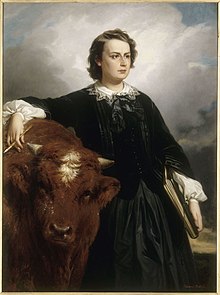
Bonheur was represented by the art dealer Ernest Gambart (1814–1902). In 1855 he brought Bonheur to the United Kingdom,[27] and he purchased the reproduction rights to her work.[28] Many engravings of Bonheur's work were created from reproductions by Charles George Lewis (1808–1880), one of the finest engravers of the day.
In 1859 her success enabled her to move to the Château de By near Fontainebleau, not far from Paris, where she lived for the rest of her life. The house is now a museum dedicated to her.
Personal life and legacy
[edit]Women were often only reluctantly educated as artists in Bonheur's day, and by becoming such a successful artist she helped to open doors to the women artists who followed her.[29]
Bonheur was known for wearing men's clothing;[30] she attributed her choice of trousers to their practicality for working with animals (see Rational dress).[31]
She lived with her first partner, Nathalie Micas, for over 40 years until Micas' death, and later began a relationship with the American painter Anna Elizabeth Klumpke.[32] At a time when lesbianism was regarded as animalistic and deranged by most French officials, Bonheur's outspokenness about her personal life was groundbreaking.[33]

In a world where gender expression was policed,[34] Bonheur broke boundaries by deciding to wear trousers, shirts and ties, although not in her painted portraits or posed photographs. She did not do this because she wanted to be a man, though she occasionally referred to herself as a grandson or brother when talking about her family; rather, she identified with the power and freedom reserved for men.[35] It also broadcast her sexuality at a time where the lesbian stereotype consisted of women who cut their hair short, wore trousers, and chain-smoked. Rosa Bonheur did all three. Bonheur never explicitly said she was a lesbian, but her lifestyle and the way she talked about her female partners suggest this.[36]
From 1800 until 2013, women in Paris, France were technically forbidden from wearing trousers without permission from police, with only a few exceptions. Enforcement of this largely stopped during World War I and after, but in Bonheur's time it was still an issue.[37][38] In the 1850s, Bonheur had to ask permission from the police to wear trousers, as this was her preferred attire to go to the sheep and cattle markets to study the animals she painted.[39]
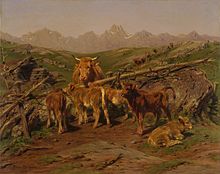
Bonheur, while taking pleasure in activities usually reserved for men (such as hunting and smoking), viewed her womanhood as something far superior to anything a man could offer or experience. She viewed men as stupid and mentioned that the only males she had time or attention for were the bulls she painted.[34]
Having chosen to never become an adjunct or appendage to a man in terms of painting, she decided she would be her own boss and that she would lean on herself and her female partners instead. She had her partners focus on the home life while she took on the role of breadwinner by concentrating on her painting. Bonheur's legacy paved the way for other lesbian artists who didn't favour the life society had laid out for them.[40]
Bonheur died on 25 May 1899, at the age of 77, at Thomery (By), France.[7] She was buried together with Nathalie Micas (1824 – 24 June 1889), her lifelong companion and lover, at Père Lachaise Cemetery, Paris. Klumpke was Bonheur's sole heir after her death,[41] and later joined Micas and Bonheur in the same cemetery upon her death. Bonheur, Micas, and Klumpke's collective tombstone reads, "Friendship is divine affection".[42] Many of her paintings, which had not previously been shown publicly, were sold at auction in Paris in 1900.[43][44]
Along with other realist painters of the 19th century, for much of the 20th century Bonheur fell from fashion, and in 1978 a critic described Ploughing in the Nivernais as "entirely forgotten and rarely dragged out from oblivion"; however, that same year it was part of a series of paintings sent to China by the French government for an exhibition titled "The French Landscape and Peasant, 1820–1905".[45] Since then her reputation has been somewhat revived.
Rosa Bonheur Memorial Park is a pet cemetery located in Elkridge, Maryland, established in 1935, and actively operated until 2002.
Art historian Linda Nochlin’s 1971 essay Why Have There Been No Great Women Artists?, considered a pioneering essay for both feminist art history and feminist art theory,[46] contains a section about and titled "Rosa Bonheur."
One of Bonheur's works, Monarchs of the Forest, sold at auction in 2008 for just over $200,000.[47]
In homage to the painter, four Parisian guinguettes bear the name Rosa Bonheur. The first opened in 2008 in the Parc des Buttes-Chaumont. It is mentioned at length by Virginie Despentes in her series of novels Vernon Subutex. The second in 2014 on the banks of the Seine at the Port des Invalides, the third in 2017 in Asnières-sur-Seine and the fourth in 2021 in the Bois de Vincennes, home of the Rosa Bonheur Modern Team (RBMT) of various sports teams and a pep band. Each of the four locations of Rosa Bonheur is home to a multilingual pop choir, collectively known as "Viens Chanter Bonheur," which is led by musician and ceramic artist Damien Bousquet.
On 16 March 2022, Google honoured Bonheur with a Doodle to mark the bicentennial of her birth.[48] The Doodle reached five countries: the United States, Ireland, France, Iceland and India.[49]
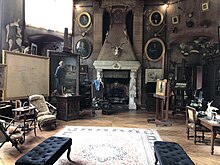
Biographical works
[edit]
The first biography of Bonheur was published during her lifetime: a pamphlet written by Eugène de Mirecourt, Les Contemporains: Rosa Bonheur, which appeared just after her Salon success with The Horse Fair in 1856.[50] Bonheur later corrected and annotated this document.[citation needed]
The 1905 book Women Painters of the World (assembled and edited by Walter Shaw Sparrow) was subtitled "from the time of Caterina Vigri, 1413–1463, to Rosa Bonheur and the present day".
The second account was written by Anna Klumpke, Bonheur's companion in the last year of her life. Klumpke's biography, published in 1909 as Rosa Bonheur: sa vie, son oeuvre, was translated in 1997 by Gretchen Van Slyke and published as Rosa Bonheur: The Artist's (Auto)biography, so-named because Klumpke had used Bonheur's first-person voice.[51]
Reminiscences of Rosa Bonheur, edited by Theodore Stanton (the son of Elizabeth Cady Stanton), was published in London and New York in 1910. It includes numerous correspondences between Bonheur and her family and friends, in which she describes her art-making practices.[52]
List of works
[edit]- Ploughing in the Nivernais, 1849
- The Horse Fair, 1852–55
- Haymaking in the Auvergne, 1853–55
- The Highland Shepherd, 1859
- A Family of Deer, 1865
- Changing meadows (Changement de pâturages), 1868
- Spanish muleteers crossing the Pyrenees (Muletiers espagnols traversent les Pyrénées), 1875
- Weaning the Calves, 1879
- Relay Hunting, 1887
- Portrait of William F. Cody, 1889
- The Monarch of the herd, 1868
Gallery
[edit]-
Changement de pâturages (1863), Hamburger Kunsthalle
-
Noon Day Rest (1877), Aberdeen Art Gallery
-
The Pyrenees (1879), Aberdeen Art Gallery
-
The Charcoal Burners (1853), Aberdeen Art Gallery
-
A Stag (1893), National Gallery of Ireland
See also
[edit]- Rosa Bonheur Memorial Park
- Prix Rosa-Bonheur (Rosa Bonheur Prize)
- Women artists
References
[edit]- ^ Carol Strickland; John Boswell (2007). The Annotated Mona Lisa: A Crash Course in Art History from Prehistoric to Post-Modern. Andrews McMeel Publishing. p. 83. ISBN 9780740768729.
- ^ "Musée d'Orsay: Rosa Bonheur Labourage nivernais". musee-orsay.fr. 25 March 2009. Archived from the original on 4 April 2019. Retrieved 24 October 2014.
- ^ "Rosa Bonheur | The Horse Fair". The Metropolitan Museum of Art.
- ^ Janson, H. W., Janson, Anthony F. History of Art. Harry N. Abrams, Inc., Publishers. 6th edition. ISBN 0-13-182895-9, page 674.
- ^ "10 Famous Female Painters Every Art Lover Should Know". My Modern Met. 30 August 2019. Retrieved 16 October 2020.
She was also an open lesbian, first living with partner Nathalie Micas for over 40 years and then, after Micas' death, forging a relationship with American painter Anna Elizabeth Klumpke. By living her life openly in an era when lesbianism was disparaged by the government, Bonheur staked her claim as a groundbreaking individual both in her career and her personal life.
- ^ "Rich, Famous and Then Forgotten: The Art of Rosa Bonheur". The New York Times. 17 October 2022. Retrieved 12 February 2023.
But Katherine Brault, the current owner of Bonheur's chateau, which is now a museum, says there is no proof that Bonheur was a lesbian. In another essay in the catalog, co-written with her daughter Lou, Brault characterizes Bonheur's relationship with Micas as an "act of independence and extraordinary sisterhood."(...)But Bonheur did not want to be a symbol for other women or for women's rights. Asked by an American newspaper in 1859 what she thought of the women's rights movement, she said, "Women's rights — women's nonsense! Women should seek to establish their rights by good and great works, and not by conventions."
- ^ a b Kuiper, Kathleen. "Rosa Bonheur", Encyclopædia Britannica Online, Retrieved 23 May 2015.
- ^ a b Heather McPherson (2003). "Bonheur, (Marie-)Rosa". Bonheur, (Marie-)Rosa [Rosalie]. doi:10.1093/gao/9781884446054.article.T009871. ISBN 9781884446054.
{{cite book}}:|website=ignored (help) - ^ Bus, Lawrence (24 May 2016). "The Realism of Rosa Bonheur". Jewish Currents. Archived from the original on 10 January 2019. Retrieved 9 January 2019.
- ^ Galton, Francis. Hereditary Genius: An Inquiry into its Laws and Consequences. Second edition. (London: MacMillan and Co, 1892), p. 247. Original 1869.
- ^ Mackay, James, The Animaliers, E.P. Dutton, Inc., New York, 1973
- ^ Rosalia Shriver, Rosa Bonheur: With a Checklist of Works in American Collections (Philadelphia: Art Alliance Press, 1982) 2-12. (It must be said that, as a reference source this book is itself riddled with inaccuracies and mis-attributions but it accords with the consensus account on this matter.)
- ^ Klumpke, Anna (2001). Rosa Bonheur: The Artist's [Auto] Biography. Ann Arbor: The University of Michigan Press. p. 87. ISBN 9780472088423.
- ^ Theodore Stanton, Reminiscences of Rosa Bonheur (New York: D. Appleton and company, 1910), Theodore Stanton, Reminiscences of Rosa Bonheur (London: Andrew Melrose, 1910).
- ^ a b Gaze, Delia, ed. (1997). Dictionary of Women Artists. Vol. I. London and Chicago: Fitzroy Dearborn Publishers. pp. 288–291. ISBN 978-1-884964-21-3.
- ^ a b Boime, Albert. "The Case of Rosa Bonheur: Why Should a Woman Want to be More Like a Man?", Art History v. 4, December 1981, p. 384-409.
- ^ Wild Spirit: The Work of Rosa Bonheur by Jen Longshaw
- ^ Ashton, Dore and Denise Browne Hare. Rosa Bonheur: A Life and a Legend, (New York: Viking, 1981, 206pp.
- ^ "Rosa Bonheur: Labourage nivernais". Musée d'Orsay. Archived from the original on 4 April 2019. Retrieved 24 October 2014.
- ^ "The Horse Fair at Albright Knox Gallery". Archived from the original on 25 June 2007. Retrieved 27 October 2018., sketch for the London version; the sketch for the New York version is in the Ludwig Nissen Foundation, see: C. Steckner, in: Bilder aus der Neuen und Alten Welt. Die Sammlung des Diamantenhändlers Ludwig Nissen, 1993, p. 142 and spaeth.net Archived 10 October 2004 at the Wayback Machine
- ^ The Horse Fair, National Gallery
- ^ Nichols, K. L. "Women's Art at the World's Columbian Fair & Exposition, Chicago 1893". Retrieved 24 July 2018.
- ^ Francis, Rell (1976). Cyrus E. Dallin Let Justice Be Done. Cyrus Dallin Art Museum. pp. 27, 39–40. LCCN 76-12352.
{{cite book}}: CS1 maint: location missing publisher (link) - ^ "Base Léonore, recensement des récipiendaires de la Légion d'honneur". culture.gouv.fr.
- ^ Great women artists. Phaidon Press. 2019. p. 65. ISBN 978-0714878775.
- ^ Stammers, Tom (5 November 2020). "Twenty Kicks in the Backside". London Review of Books 42 (21): 17–20.
- ^ Christiane, Weidemann (2008). 50 women artists you should know. Larass, Petra., Klier, Melanie, 1970-. Munich: Prestel. ISBN 9783791339566. OCLC 195744889.
- ^ "Ernest Gambart". goodallartists.ca.
- ^ Stanton, Theodore (1910). Reminiscences of Rosa Bonheur (with twenty-four full-page illustrations and fifteen line drawings in the text. A. Melrose. p. 64.
- ^ Britta C. Dwyer, "Bridging the gap of difference: Anna Klumpke's "union" with Rosa Bonheur", Out of context. (New York: Greenwood Press, 2004), p. 69-79.; Laurel Lampela, "Daring to be different: a look at three lesbian artists", Art Education v.54 no. 2 (March 2001), p. 45-51. and Gretchen Van Slyke, "The sexual and textual politics of dress: Rosa Bonheur and her cross-dressing permits", Nineteenth-Century French Studies v. 26 no. 3-4 (Spring/Summer 1998) p. 321-35.
- ^ Janson: History of Art, page 929
- ^ Blume, Mary; Tribune, International Herald (4 October 1997). "The Rise and Fall of Rosa Bonheur". The New York Times. ISSN 0362-4331. Retrieved 14 March 2018.
- ^ Encyclopedia of Lesbian and Gay Histories and Cultures: An Encyclopedia. Gay histories and cultures. Vol. 2. Taylor & Francis. 2000. ISBN 9780815333548.
- ^ a b Boime, Albert (December 1981). "The case of Rosa Bonheur: Why should a woman want to be more like a man?". Art History. 4 (4): 384–409. doi:10.1111/j.1467-8365.1981.tb00733.x.
- ^ Van Slyke, Gretchen (January 1999). "Gynocentric matrimony: The fin-de-siécle alliance of Rosa Bonheur and Anna Klumpke". Nineteenth-Century Contexts. 20 (4): 489–502. doi:10.1080/08905499908583461. PMID 22039638.
- ^ Zimmerman, Bonnie (2013). Encyclopedia of Lesbian Histories and Cultures. Hoboken: Taylor & Francis. p. 125. ISBN 9781136787515.
- ^ "Was it really illegal for women in France to wear trousers until 2013?".
- ^ Wills, Matthew (28 May 2022). "Rosa Bonheur's Permission to Wear Pants". JSTOR Daily. Retrieved 23 November 2022.
- ^ France, Connexion. "Women wearing trousers was illegal in France until 2013". www.connexionfrance.com. Retrieved 24 April 2021.
- ^ Lampela, Laurel (2001). "Daring to Be Different: A Look at Three Lesbian Artists". Art Education. 54 (2): 45–54. doi:10.2307/3193946. JSTOR 3193946. S2CID 189018696.
- ^ "The late Rosa Bonheur's relatives have been defeated in their contest over the great painter's will. It will be remembered that Miss Klumpke, the artist, was the legatee, and the courts have decided largely in her favor, all of the property, except the paintings, being awarded her, while the proceeds of the paintings, which are to be sold at auction, are to be equally divided between Miss Klumpke and the relatives." "Foreign Notes," Mark Hopkins Institute Review of Art, Sept. 1900, vol. 1 no. 2, p. 17.
- ^ "The eight women artists of The National Gallery | Art UK". artuk.org. Retrieved 4 March 2023.
- ^ Chisholm, Hugh, ed. (1911). . Encyclopædia Britannica (11th ed.). Cambridge University Press.
- ^ Galerie Georges Petit. 1er. Tome, Catalogue des tableaux par Rosa Bonheur, May 30-June 2, 1900. 2eme Tome, Aquarelles, dessins, gravures par Rosa Bonheur, June 5–8, 1900.
- ^ Muratova, Xenia (1978). "Current and Forthcoming Exhibitions: Paris and China". The Burlington Magazine. 120 (901): 257–60. JSTOR 879183.
- ^ Rijsingen, Miriam van (1995). "How purple can it be?: Feminist art history". In Rosemarie Buikema, Anneke Smeli (ed.). Women's Studies and Culture: A Feminist Introduction. Palgrave Macmillan. pp. 94–105. ISBN 9781856493123.
- ^ Christie's. "Rosa Bonheur (French, 1822-1899)". christies.com.
- ^ "Google". www.google.com. Retrieved 16 March 2022.
- ^ "Remembering French painter Rosa Bonheur". www.aljazeera.com. Retrieved 16 March 2022.
- ^ Eugène de Mirecourt, Les Contemporains: Rosa Bonheur (Paris: Gustave Havard, 15 Rue Guénégaud, 1856) 20.
- ^ Anna Klumpke, Rosa Bonheur: Sa Vie, Son Oeuvre, (Paris: E. Flammarion, 1909), Anna Klumpke, Rosa Bonheur: The Artist's (Auto)Biography, trans. Gretchen Van Slyke (Ann Arbor: University of Michigan Press, 1998).
- ^ Theodore Stanton, Reminiscences of Rosa Bonheur, (New York: D. Appleton and company, 1910), Theodore Stanton, Reminiscences of Rosa Bonheur, (London: Andrew Melrose, 1910).
Resources
[edit]- NMWA.org Collection Profile - Bonheur article and artwork at NMWA.
Further reading
[edit]- Dore Ashton, Rosa Bonheur: A Life and a Legend. Illustrations and Captions by Denise Browne Harethe. New York: A Studio Book/The Viking Press, 1981 NYT Review
- Catherine Hewitt, Art is a Tyrant: The Unconventional Life of Rosa Bonheur. UK Published by Icon Books Ltd in 2020.
- Isabella Zuralski-Yeager, "Tedesco Frères Selling Rosa Bonheur: An Inquiry into Dealers’ Stock Books." The Getty Research Journal, vol. 16, 2022, https://www.journals.uchicago.edu/doi/10.1086/721990.
External links
[edit]- Joseph J. Rishel, “Barbaro after the Hunt by Marie-Rosalie Bonheur (W1900-1-2)[permanent dead link],” in The John G. Johnson Collection: A History and Selected Works[permanent dead link], a Philadelphia Museum of Art free digital publication.
- How France is leveraging a lottery to finance historic preservation, 2020 PBS Newshour report with interior scenes of Bonheur's atelier
- 20 artworks by or after Rosa Bonheur at the Art UK site
- Rosa Bonheur - Artcyclopedia search
- Rosa Bonheur - Rehs Galleries' biographical information and an image of her painting Couching Lion, 1872
- Rosa Bonheur Plowing in the Nivernais (1849). A video discussion about the painting from smarthistory.khanacademy.org
- A life without Compromise — Rosa Bonheur biography, artworks and writings on Trivium Art History
- Art and the empire city: New York, 1825-1861, an exhibition catalog from The Metropolitan Museum of Art (fully available online as PDF), which contains material on Bonheur (see index)
- "Bonheur, Rosa,--1822-1899." Library of Congress
- Rosa Bonheur in American public collections, on the French Sculpture Census website
- Portraits of Rosa Bonheur at the National Portrait Gallery, London
 KSF
KSF



